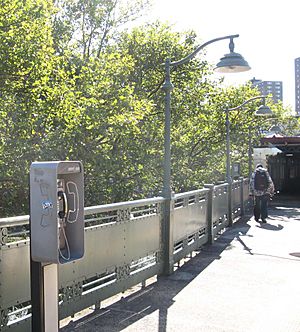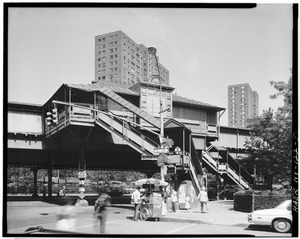Jackson Avenue station (IRT White Plains Road Line) facts for kids
Quick facts for kids
Jackson Avenue
|
|||||||||
|---|---|---|---|---|---|---|---|---|---|

Northbound platform
|
|||||||||
| Station statistics | |||||||||
| Address | Jackson Avenue & Westchester Avenue Bronx, NY 10455 |
||||||||
| Borough | The Bronx | ||||||||
| Locale | Melrose | ||||||||
| Coordinates | 40°48′59″N 73°54′29″W / 40.81639°N 73.90806°W | ||||||||
| Division | A (IRT) | ||||||||
| Line | IRT White Plains Road Line | ||||||||
| Services | 2 alltimes (all times) 5 allexceptrush (all except late nights and rush hours, peak direction) |
||||||||
| Transit connections | |||||||||
| Structure | Elevated | ||||||||
| Platforms | 2 side platforms | ||||||||
| Tracks | 3 | ||||||||
| Other information | |||||||||
| Opened | November 26, 1904 (3rd Ave. Line; Bergen Avenue bypass) July 10, 1905 (White Plains Rd. Line) |
||||||||
| Station code | 433 | ||||||||
| Opposite-direction transfer available | No | ||||||||
| Traffic | |||||||||
| Passengers (2019) | 1,584,727 |
||||||||
| Rank | 283 out of 425 | ||||||||
| Station succession | |||||||||
| Next north | Prospect Avenue: 2 alltimes 5 allexceptrush | ||||||||
| Next south | Third Avenue–149th Street: 2 alltimes 5 allexceptrush 143rd Street (Third Ave elevated; demolished) |
||||||||
|
|||||||||
|
|||||||||
|
|||||||||
|
Jackson Avenue Subway Station (IRT)
|
|||||||||

HABS image of the northbound station house and staircase at 152nd Street
|
|||||||||
| MPS | New York City Subway System MPS | ||||||||
| NRHP reference No. | 04001025 | ||||||||
| Added to NRHP | September 17, 2004 | ||||||||
The Jackson Avenue subway station is located in Melrose, Bronx, New York. It's part of the IRT White Plains Road Line of the New York City Subway. This station is served by the 2 train all the time. The 5 train also stops here, except late at night and during busy travel times in the main direction.
The Jackson Avenue station first opened on November 26, 1904. It was one of the first stations on the IRT White Plains Road Line. At first, trains from other elevated lines used this station. Direct subway service began in 1905. Over the years, the station's platforms were made longer to handle more trains. In 1977, a fire damaged part of the station. Since 2004, the station has been recognized as a historic place.
Contents
Station History
Building the Subway
The plan to build New York City's first subway system began in 1900. This big project aimed to connect different parts of the city. The first section of the IRT White Plains Road Line, which includes Jackson Avenue, opened on November 26, 1904.
Initially, trains from the IRT Second Avenue Line and IRT Third Avenue Line used this station. They connected to the White Plains Road Line. On July 10, 1905, subway trains from the new IRT Lenox Avenue Line started running through Jackson Avenue. This made it easier for people to travel.
Growing and Changing
By 1909, more people were using the subway, and stations became crowded. To fix this, officials decided to make the platforms longer. This would allow more train cars to stop at the station. The northbound platform at Jackson Avenue was extended in 1910.
In 1917, a new connection was added between the White Plains Road Line and the Third Avenue elevated line. This connection was called the Bergen Avenue cutoff. It helped trains bypass a busy station. However, this connection was closed in 1946 as parts of the elevated train system were removed.
In 1949, the southbound platform at Jackson Avenue was also extended. This meant that longer, ten-car express trains could fully open their doors at the station. Before this, only shorter local trains could stop properly.
Modern Updates
In 1976, a fire damaged the ticket booth and a waiting area on the northbound platform. Because not many people used that specific entrance, the city decided not to rebuild the ticket booth. Instead, they installed a special turnstile that allows people to enter and exit without a ticket agent. This was a way to save money while still letting passengers use the platform.
Station Design and Art
Tracks and Platforms
The Jackson Avenue station has three tracks and two side platforms. A side platform is a platform located on the side of the tracks, not between them. The middle track is used by the 5 train during busy times, allowing it to go faster.
West of the station, the elevated tracks widen. This is where old connections to the Third Avenue Line used to be. The line then curves west and goes into a tunnel. Because the station is close to this tunnel, it is lower to the ground than other elevated stations further north.
Both platforms have beige windscreens with green outlines. They also have red roofs with green support frames. The station signs are black with white letters, which is the standard design.
Cool Architecture
The station's elevated structure is supported by strong columns on each side of the road. The station houses, where you enter and exit, are built in a style called Queen Anne style. This style often features decorative roofs and details.
The station houses were designed by Heins & LaFarge. They have steel frames and sloped roofs. The middle part of each station house has special windows called dormers that help with air flow. The roofs have decorative metal crests. Inside, there used to be small waiting areas and restrooms, but the restrooms are now used for storage.
Art at the Station
Since September 17, 2004, the Jackson Avenue station has been listed on the National Register of Historic Places. This is because it's one of the very first stations built for the IRT subway system.
In 2009, artist George Crespo created an artwork for the station called Latin American Stories. It includes four colorful stained glass panels on the windscreens of each platform. There are also two sets of window designs in each station house. These artworks show scenes from six different Latin American stories, like "How Fire Came to the Rain Forest."
Getting In and Out
Entrances and Exits
Each platform at Jackson Avenue has its own station house, located near the back of the platform. There are no ways to cross between the platforms inside the station. This means if you are on the wrong platform, you have to exit the station and re-enter on the other side.
On the platform for trains going towards Manhattan, doors lead to a small waiting area. Here, you'll find turnstiles to enter or exit the station. Outside the turnstiles, there is a ticket booth and two staircases that go down to the west side of Westchester Avenue. There are also special exit-only turnstiles on the platform, so passengers can leave quickly without going through the main station house.
The station house on the northbound platform (for trains going away from Manhattan) does not have staff. It has special turnstiles that allow both entry and exit. Outside these turnstiles, stairs lead down to the northeast corner of Westchester and Jackson Avenues. There is also an exit-only turnstile on this platform for quick exits.
Images for kids
See also
 In Spanish: Avenida Jackson (línea White Plains Road) para niños
In Spanish: Avenida Jackson (línea White Plains Road) para niños





